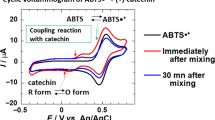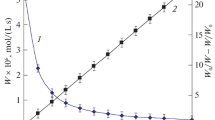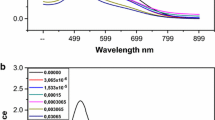Abstract
Here we are presenting complete electrochemical studies on redox activities of 1,2-dinitrobenzene (DNB) in the presence of antioxidants–quercetin, morin, rutin, ascorbic acid and β-carotene. Bimolecular rate constants (k2), antioxidant activities (Ka) and diffusion coefficients (Do) were evaluated from changes in voltammeric responses and electrochemical parameters in the presence of antioxidant’s concentrations. Theoretical charge calculations by PM3 parameterization were done which further justified our experimental electrochemical work and proposed scavenging mechanism. Present findings were also compared in details with our previously reported studies on 1,3- and 1,4-dinitrobenzene systems for their interactions with antioxidants.
Similar content being viewed by others
References
Lobo, V., Patil, A., Phatak, A., and Chandra, N., Free radicals, antioxidants and functional foods: impact on human health, Pharmacogn. Rev., 2010, vol. 4, no. 8, p. 118.
Vaya, J. and Aviram, M., Nutritional antioxidants mechanisms of action, analysis of activities and medical applications, Curr. Med. Chem. Immunol. Endocr. Met. Agents, 2001, vol. 1, no. 1, p. 99.
Fridovich, I., The biology of oxygen radicals, Science, 1978, vol. 201, no. 4359, p. 875.
Nohl, H., Jordan, W., and Dietmer, H., Identification of free hydroxyl radicals in respiring rat heart mitochondria by spin trapping with the nitrone DMPO, FEBS Lett., 1981, vol. 123, no. 2, p. 241.
Bors, W., Michel, C., and Stettmaier K., Antioxidant effects of flavonoids, Bio-Factors, 1997, vol. 6, no. 4, p. 399.
Nunomura, A., Castellani, R.J., Zhu, X., Moreira, P., Perry, G., and Smith, M.A., Involvement of oxidative stress in Alzheimer disease, J. Neuropathol. Exp. Neurol., 2006, vol. 65, no. 7, p. 631.
Kaczmar, A.W., Gandhi, S., and Wood, N.W., Understanding the molecular causes of Parkinson’s disease, Trends Mol. Med., 2006, vol. 12, no. 11, p. 521.
Hitchon, C.A. and El-Gabalawy, H.S., Review: oxidation in rheumatoid arthritis, Arthritis Res. Ther., 2004, vol. 6, p. 265.
Valko, M., Leibfritz, D., Moncol, J., Cronin, M.T.D., Mazur, M., and Telser, J., Free radicals and antioxidants in normal physiological functions and human disease, Int. J. Biochem. Cell Biol., 2007, vol. 39, no. 1, p. 44.
Van, G. L.F., Mertens, I.L., and De-Block, C.E., Mechanisms linking obesity with cardiovascular disease, Nature, 2006, vol. 444, no. 7121, p. 875.
Fereshteh, A., Simon, G.M., Morteza, H.C., Gholamreza, B., and Mohammad, S.J., Review: molecular mechanisms behind free radical scavengers function against oxidative stress, Antioxidants, 2017, vol. 6, p. 51.
Satish, B.N. and Dilipkumar, P., Review: free radicals, natural antioxidants, and their reaction mechanisms, RSC Adv., 2015, vol. 5, p. 27986.
Anu, R.A.K., Vivek, S., Brijesh, Y., Ruchi, T., Sandip, C., and Kuldeep, D., Review article: oxidative stress, prooxidants, and antioxidants: the interplay, Biomed. Res. Int., 2014, vol. 2014, p. 761264.
Haiying, F., Mingzhang, L., Yusa, M., Kuniki, H., Yosuke, K., Akinari, Y., Naoya, S., and Yoshihiko, H., Free radical scavenging reactions and antioxidant activities of silybin: mechanistic aspects and pulse radiolytic studies, Free Radic. Res., 2009, vol. 43, no. 9, p. 887.
Nasima, A., Naveed, K.J., Athar, Y.K., Javeed, H.Z., and Leif, H.S., Electrochemical studies of interactional mechanism and scavenging activity of antioxidants towards dinitroaromatics, Montash. Chem., 2012, vol. 143, p. 377.
Nasima, A., Naveed, K.J., Athar, Y.K., Azra, Y., Torsten, B., and Claus, J., Natural flavonoids interact with dinitrobenzene system in aprotic media: an electrochemical probing, Nat. Prod. Commun., 2012, vol. 7, no. 3, p. 311.
Nasima, A., Naveed, K.J., Safeer, A., Athar, Y.K., and Leif, H.S., Electrochemical investigations of antioxi-dant interactions with anion-radicaland dianion of 1,3-dinitrobenzene, Electrochem. Acta, 2009, vol. 54, p. 6184.
Ai-Hong, Y., Xue-Ying, S., Xue, L., Fang-Fang, L., Qin-Qin, Z., Shu-Xin, J., Jian-Zhong, C., and Hongling, G., Spectroscopic and electrochemical studies on the evaluation of the radical scavenging activities of luteolin by chelating iron, RSC Adv., 2014, vol. 48, p. 25227.
Agarwal, A., Environmental toxicants and testicular apoptosis, Open Reprod. Sci. J., 2011, vol. 3, no. 1, p. 114.
Farzana, H., Ghazala, Y., Rashida, P., and Muhammad, A., Protonation reaction of anion radicals of some dinitroaromatics in hexamethylphosphortriamide (HMPA), J. Chem. Soc. Pak., 2014, vol. 36, no. 3, p. 422.
Syroeshkin, M.A., Mendkovich, A.S., Mikhal’chenko, L.V., and Gul’tyai, V.P., The nature of associates of 1,4-dinitrobenzene dianion with 1butyl3methylimidazolium and 1butyl2,3dimethylimidazolium cations, Russ. Chem. Bull. Int. Ed., 2009, vol. 58, no. 8, p. 1688.
Ruvalcaba, M.N.A., Gonzalez, I., and Martinez, M.A., Evolution from hydrogen bond to proton transfer pathways in the electroreduction of α-NH-Quinones in acetonitrile, J. Electrochem. Soc., 2004, vol. 151, no. 3, p. e110.
Leonor, C.C., Martin, S.L., and Smith, D.K., Electrochemically controlled hydrogen bonding. redoxdependent formation of a 2:1 diarylurea/dinitrobenzene2–complex, J. Org. Chem., 2005, vol. 70, p. 10817.
Mendkovich, A.S., Syroeshkin, M.A., Mikhalchenko, L.V., Mikhailov, M.N., Rusakov, A.I., and Gul’tyai, V.P., Integrated study of the dinitrobenzene electroreduction mechanism by electroanalytical and computational methods, Int. J. Electrochem., 2011, vol. 2011, 12 p.
Nasima, A., Moazzam, H.B., Shahid, I.F., Samreen, S., and Bushra, M., Synthesis, photochemical and electrochemical studies on triphenyltin(IV) derivative of (Z)-4-(4-cyanophenylamino)-4-oxobut-2-enoic acid for its binding with DNA: biological interpretation, Arab. J. Chem., 2016, vol. 9, no. 3, p. 451.
Nasima, A., Mukhtar, A., Muhammad, Z.A., and Humaira, N., Spectroscopic, electrochemical DNA binding and in vivo anti-inflammatory studies on newly synthesized Schiff bases of 4-aminophenazone, J. Photochem. Photobiol. B: Biol., 2014, vol. 138, p. 331.
Wang, J., Analytical Chemistry, VCH, 1994, chapt. 6, p. 166.
Niranjana, E., Naik, R.R., Swamy, K.B.E., Bodke, Y.D., Sherigara, B.S., Jayadevappa, H., and Badami, B.V., Cyclic voltammetric investigations of 3-aryl-4-bromo sydnone and its derivatives at glassy carbon electrode, Int. J. Electrochem. Sci., 2008, vol. 3, p. 980.
Grimshaw, J., Electrochemical Reactions and Mechanisms in Organic Chemistry, Elsevier, 2000.
Mohammad, M., Khan, A.Y., Begum, W., Ashraf, N., Qurashi, R., and Iqbal, R., Protonation of anion radicals and dianions of some dinitro aromatics, Res. Chem. Intermed., 1991, vol. 16, no. 1, p. 29.
Nicholson, R.S. and Shain, I., Theory of stationary electrode polarography. Single scan and cyclic methods applied to reversible, irreversible, and kinetic systems, Anal. Chem., 1964, vol. 36, p. 706.
Miller, N.E., Wander, M.C., and Cave, R.J., A theoretical study of the electronic coupling element for electron transfer in water, J. Phys. Chem. A, 1999, vol. 103, p. 1084.
Sawyer, D.T., Experimental Electrochemistry for Chemists, Wiley, 1974, p. 170.
Gómez, M., González, F.J., and González, I., Intra and intermolecular hydrogen bonding effects in the electrochemical reduction of α-phenolic-naphthoquinones, J. Electroanal. Chem., 2005, vol. 578, no. 2, p. 193.
Korotkova, E.I., Avramchik, O.A., Kagiya, T.V., Karbainov, Y.A., and Tcherdyntseva, N.V., Study of antioxidant properties of a water-soluble vitamin E derivative-tocopherol monoglucoside (TMG) by differential pulse voltammetry, Talanta, 2004, vol. 63, no. 3, p. 729.
Ziyatdinova, G.K., Budnikov, H.C., and Pogorel’tzev, V.I., Electrochemical determination of the total antioxidant capacity of human plasma, Anal. Bioanal. Chem., 2005, vol. 381, p. 1546.
Author information
Authors and Affiliations
Corresponding author
Additional information
Published in Russian in Elektrokhimiya, 2019, Vol. 55, No. 2, pp. 191–213.
The article is published in the original.
Rights and permissions
About this article
Cite this article
Arshad, N., Janjua, N.K. Kinetics, Mechanistic and Theoretical Studies on Scavenging Activities of Antioxidants Using 1,2-Dinitrobenzene DNB/DNB•− and DNB/DNB2– Model Systems: Cyclic Voltammetric and Quantum Semi-Empirical Data Interpretation. Russ J Electrochem 54, 1252–1273 (2018). https://doi.org/10.1134/S1023193518140021
Received:
Accepted:
Published:
Issue Date:
DOI: https://doi.org/10.1134/S1023193518140021




